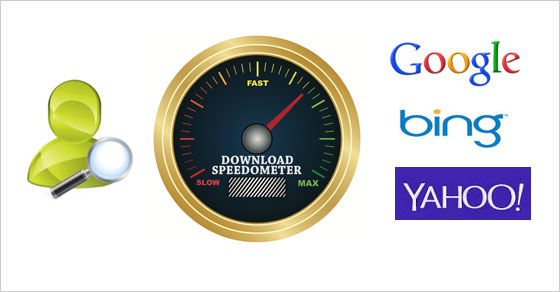
By Shari Thurow, from Search Engine Land – http://selnd.com/R7Hoy0
Download time has been an important part of page/image/video/etc., optimization for a very long time. It was important in the 1990s when connectivity was not as advanced as it is today. It is important now due to the proliferation of mobile technology. I am sure it will continue to be important in the future.
However, one thing has been consistent since I’ve focused on minimizing download time: my focus has always been user/searcher first, technology second.
After all, Google is not going to Add to Cart. Bing is not going to sign up for your class. Twitter is not going to subscribe to your RSS feed.
Humans are our ultimate target audience.
Even so, I’ve also long recognized that users/searchers use technology to accomplish their goals. Therefore, online marketers should not forget that technology could be a legitimate (and important) user.
The site optimization process should accommodate both humans and technology.

Herein lies the problem: which is more important to users? What Google considers to be download time? Or what other human/computer interface (HCI) professionals have been saying for years: perceived download time?
And now for the smackdown…
Human Speed – Perceived Download Time
What astounds me about this smackdown is that some software engineers know how important perceived download time is. But they do not differentiate actual download time and perceived download time.
Here are some citations from the Microsoft Developer’s Network Library:
“Because of the graphical nature of Microsoft Windows, the speed of graphics and other display operations is crucial to the perceived speed of the application. The faster forms appear and paint, the faster your application will seem to the user. There are several techniques you can use to speed up the apparent speed of your application….”
Optimizing Display Speed, Microsoft Developer’s Network
“Often the subjective speed of your application has little to do with how quickly it actually executes its code. To the user, an application that starts up rapidly, repaints quickly, and provides continuous feedback feels “snappier” than an application that just “hangs up” while it churns through its work.
Optimizing Perceived Speed, Microsoft Developer’s Network
Long ago, the folks at User Interface Engineering (UIE) determined that perceived download time depended on context. When users accomplish what they set out to do on a website, they perceive that site’s download time to be fast. When users cannot find what they want on a website? They will regard the website’s download time to be slow.
Like many HCI professionals, I also believe that users’ perceived download time depends on context. Will users abandon a website purely due to its perceived download time?
“…perceptions of download waiting are found to be more reliable than actual waits in predicting web site abandoning. Finally, delays near the start of the download are perceived as longer than later in the process, and time pressure worsens the effect of download waiting at the earlier stages of delay.”
Dabholkara, P. and Shenga, X. (2008). “Perceptions of download delays: relation to actual waits, web site abandoning, and stage of delay.” The Service Industries Journal 28(10), pp.1415-1429.
As I mentioned previously, I believe download time is critical to a positive user and searcher experience online. I would not have named it a Universal Principal of Web Design if I did not believe it was important. However, unlike technocentric and data-obsessed people, I want to measure download time in the proper context.
I want to differentiate machine speed vs. perceived speed. I want to identify true reasons for site abandonment. Because if I look at numbers in the wrong context, I might not get the correct solution.
Machine Speed – Search Engine Download Time
Google has a tool called PageSpeed Insights which allows online marketers and search engine optimization (SEO) professionals to test their page speed on different devices. It then provides suggestions for how to improve page speed.
Google also provides some Web Performance Best Practices and solutions for website owners, including:
- Leveraging browser caching
- Minimize DNS lookups
- Minimize redirects
- Avoid bad requests
- Combine images using CSS sprites
- Avoid document.write
- Avoid CSS @import
- Prefer asynchronous resources
- Defer parsing of JavaScript
As I went through these guidelines, I read download-time strategies I have known and implemented for many years (about optimizing images, scripts and style sheets). Google has some new guidelines for mobile devices, as well.
For those of you who are not developers, most of these tips are pure technobabble. But, I ask you to go through these guidelines regardless of your level of technical knowledge. Is the emphasis in these guidelines on machine speed… or is the emphasis on the user/searcher experience?
I am certainly not discounting Google’s support in helping us webmasters deliver web documents more quickly. In fact, I am quite grateful for the support.
Nevertheless, I always come back to context. A number without context is just a number. Data without context (or the right context) can and is often misinterpreted. Making a digital document better for Google does not necessarily mean you are making that digital document better for your end users.
Context Is QUEEN
The perception of download time depends on context. Some factors that affect download time include (but are not limited to):
- Gender
- Time online
- Economic factors
- Perceived length of wait
- Attitude to delay (patient vs. impatient people)
- User expectations
- Type of task
- Uncertainty and information about the wait
For example, people who are searching (querying) for specific information have a lower tolerance for download time than people who are simply surfing or browsing the web. Additionally, a Google study found that patterns for evaluating listings in search results are influenced by gender and not by task type.
So, what is my point about download time? Am I saying that human speed is more important than machine speed? Am I saying that machine and human speed are equally important?
I don’t believe that machine speed ultimately determines the quality of information delivered on a web page. Fast or slow, poor website content is still poor website content.
However, if users and searchers can accomplish their goals more easily on quality web pages with a fast download time (machine speed?), then that is a better user experience.
Humans first, technology second.
